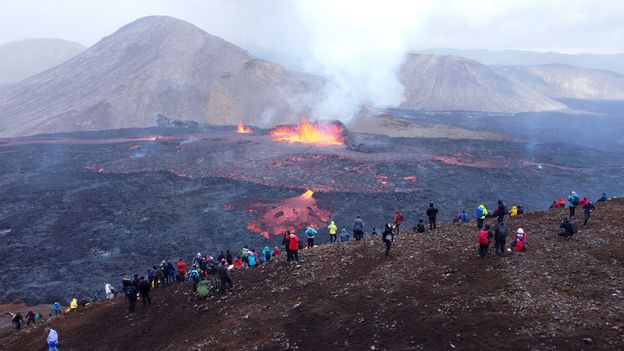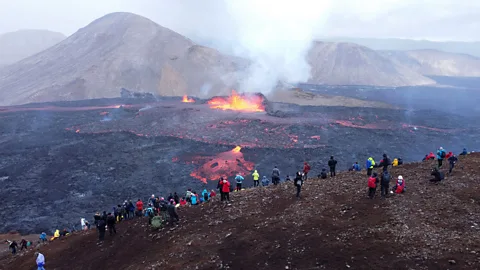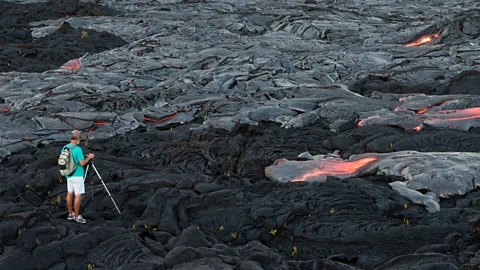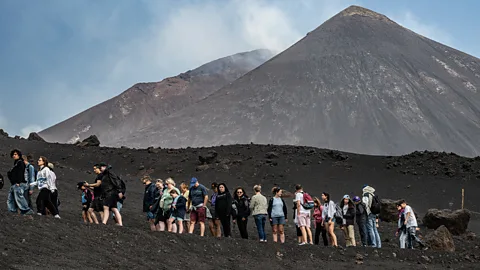Travel
How safe is volcano tourism?

 Getty Images
Getty ImagesAs far as volcano tourism goes travellers tend to fall into two camps: those who stay clear and those who want to get closer.
Volcano tourism has been increasing since British businessman Thomas Cook took the first group of visitors to see Mount Vesuvius in 1841. Today, millions of people flock to places like Iceland, Italy and Hawai’i to experience the explosive power of local volcanoes. There’s also an increasing number of ways for travellers to experience these natural formations, from a simple hike at Volcanoes National Park in Hawai’i to rappelling into an active volcano in Vanuatu’s Ambrym Island.
In Iceland, one of the country’s most visited sites, the Blue Lagoon spa, has recently been evacuated because of volcanic activity in the area, the fifth such eruption since December 2023. The spa, which is located just 5km from the small fishing town of Grindavík where the eruption took place, is heated by geothermal power thanks to its location in a lava field. Though there are no reported deaths associated with this eruption, several incidents of tourist deaths at other volcanoes have left many people questioning the safety of volcano tourism as a whole.
In 2019, 22 people died and 25 were injured on a tourist expedition to Whakaari/White Island, a stratovolcano off New Zealand’s coast, when superheated steam erupted from the volcano – a tragedy explored in the 2022 Netflix documentary The Volcano: Rescue From Whakaari. In 2023, one of the most active and popular volcanoes on the Indonesian island of Sumatra, Mount Marapi, killed 23 hikers and injured dozens more when it unexpectedly spewed superheated ash.
So, is volcano tourism safe? Luckily for adventure travellers, experts say yes – with some very important caveats.
 Getty Images
Getty ImagesFirst, doing a little research ahead of time is crucial. “When folks are going to a volcano for volcano tourism, they really have to educate themselves,” says Matthew Patrick, a geologist at the Hawaiian Volcano Observatory. “Read up about what the restrictions are, what the local authorities are doing to keep people out and keep people safe.” This includes checking local tourism websites for updated safety information and signing up for text alerts when visiting national parks.
Next, if you’re travelling to an active volcano, it’s best to go with a reputable guide. While it’s true that some places, like Acatenango volcano in Guatemala, allow tourists to visit on their own, a guided tour of active volcanoes is best from a safety perspective.
“Each volcano is different, so people have to be aware of that,” says Patrick. “Some volcanoes in Hawai’i, in years past, you could basically walk up to the lava flows with reasonable safety. But obviously, you wouldn’t want to be that close to an explosive volcano.”
There may also be cultural considerations, such as at Volcanoes National Park. In Indigenous Hawaiian culture, volcanoes are considered living beings and eruptions are a time of deep cultural and spiritual significance. Scientists and visitors alike are asked to be as respectful as possible to the deep meaning that volcanoes have for this community. Measures for respectful visiting include not interrupting the flow of lava, not removing plants or rocks from the area and not taking photos or videos of Indigenous Hawaiians who might be praying near the area.
Most tourism boards offer guidance on how to best visit local volcanoes responsibly – if at all. In the wake of the recent Icelandic eruption, the country’s tourism website has a page specifically dedicated to providing up-to-date information. Though evacuation measures are currently in effect on the Reykjanes peninsula, where the eruptions have occurred, operations in the rest of the country are resuming as normal.
 Getty Images
Getty ImagesAccording to Kristín Vogfjorð, leader of Geoscience Research at the Icelandic Meteorological Office, advancements in predicting eruptions and other dangerous phenomenon, such as toxic gas emissions associated with volcanoes, have made volcano tourism much safer, not just in Iceland, but around the world. “We’ve been able to forecast some eruptions in Iceland even since 2000,” says Vogfjorð. “Forecasting eruptions within hours is not that difficult. But still, sometimes they manage to surprise us.”
Not only do volcanologists now have the ability to predict the likelihood of activity in advance, but important collaborations between scientists and local officials mean that many places, such as Iceland and the US, have systems in place to convey this information directly to both locals and visitors almost in real time.
“There is an automatic notification connected to one of the monitors monitoring seismicity,” Vogfjorð explains. “So that alerts [the authorities] that something is going to happen. When they reach [certain] levels, automatic messages go out to all phones in the area.” According to Vogfjorð, in the event of an emergency these automated messages go out in several languages to every mobile phone within range of the volcano, including those belonging to travellers.
Tourists interested in getting a closer view of Iceland’s current eruption may have a long wait, as scientists believe the volcanic activity in the area could last for the next few decades, or even centuries.



)






